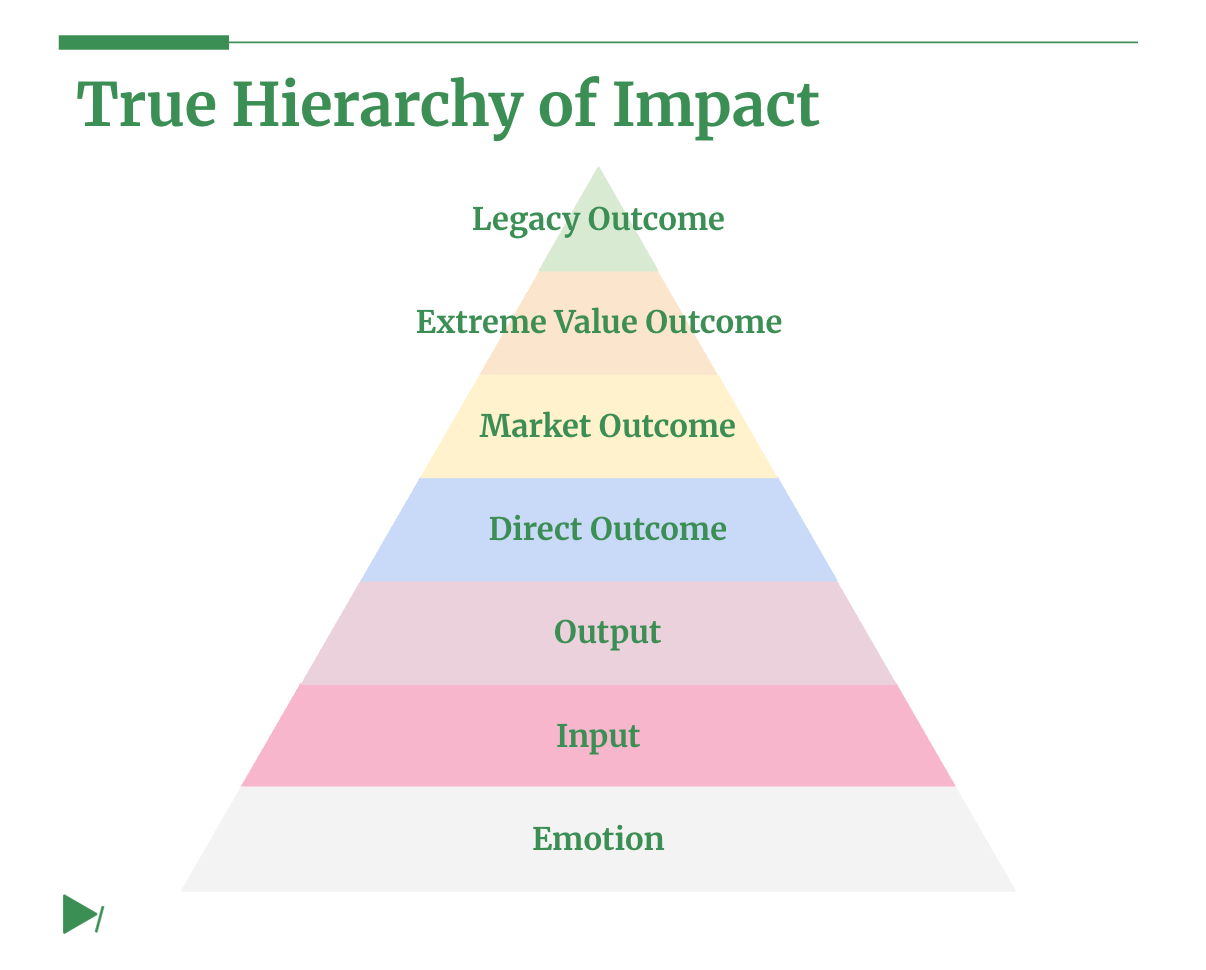The True Hierarchy of Impact
What different levels of impact actually are and how we should be thinking about them.
Everyone talks about making an impact. Almost no one asks what it actually means.
“Impact” has become a performative script—used to justify everything from training AI on copyrighted content to reviving fracking. As long as there’s a feel-good story to tell, a metric to show, or a headline to grab, we call it “impact.”
The uncomfortable truth is that not all impact is created equal, or is true to begin with. Just because something is big, popular, or profitable doesn’t mean it matters.
To know if it has a true impact, we have to ask ourselves:
If you didn’t exist, how would the world look like?
The answer to this question is the real difference between noise and signal, between being part of a system and changing it, and between meaningless and meaningful.
The True Hierarchy of Impact
This framework was born from a simple but sobering observation over the past decade of investing: Most people, firms, and investments are not net contributors—we are simply replaceable. Our absence would cause inconvenience but not loss.
This has profound implications in the era of AI, which is gradually but surely replacing many of our economic and, very soon, social functions. To survive and thrive, we need to climb up the hierarchy of impact and become irreplaceable.
The True Hierarchy of Impact maps impact across seven levels—from shallow to deep, from local to systemic, from temporary to time-transcending.
Level 1: Emotion
Feel-good action with no measurable change. We feel good about doing something that we think is good, but it may not necessarily be good for the target audience (intention > action). For example, performative charity events to donate to whatever we feel good about donating to (but would they have been better off just receiving direct donation?).
Level 1 Impact = Sum of all positive feelings by taking this action
Level 2: Input
Input action without clear output or outcomes. We take action (usually allocating resources such as time, money, and energy) towards a goal that is not necessarily good for the target audience (input > output). For example, the number of jobs created by doing business (but would these jobs lead to any better output?). Most businesses operate here. Most of us live here.
Level 2 Impact = Sum of all inputs that sound nice
Level 3: Output
Volume of activity (users, reach, revenue) with unclear value delivered. We serve many customers/ users for a service that may not have any depth (quantitative output > qualitative output). For example, the number of customers we have served (but would they have been worse off without the service?). Most businesses market to be here.
Level 3 Impact = Total # of people served
Level 4: Direct Outcome
Measurable improvement in people’s lives—tangible before/after delta. We take action that directly benefits people in a meaningful way. For example, # of patients’ disease cured by a healthtech company (but could they have been serviced otherwise?). Most impact investing is here.
Level 4 Impact = Total # of people directly served x % of life improved
Level 5: Market Outcome
Second-order change—others copy, adapt, or build on top of the work. We take action that enables/ pressures others to change their action that benefits people in a meaningful way. For example, # of total people purchasing EVs by automakers as a result of Tesla’s (somewhat historical) success (but would they have been major benefits?). Top impact investing is here.
Level 5 Impact = Total # of people indirectly served x % of life improved
Level 6: Extreme Value Outcome
Solutions to make-or-break problems for those in need. We take action that directly or indirectly benefits people in a way that changes their life outcome. For example, # of life-or-death situations solved by a healthtech company (but would they have been one-off or recurring?). Most of us still don’t think this way- extremes are too extreme for us to comprehend.
Level 6 Impact = Total # of critical cases directly or indirectly solved
Level 7: Legacy Outcome
Enduring impact that reshapes the arc of history. We take action that not only solves immediate or critical needs but also alters the trajectory of individuals, systems, or civilizations over time. For example, the discovery of germ theory (foundational science) or the creation of the internet (infrastructure shift). And this is where we stand today with AI, climate change, and geopolitics— how we let them happen can make or break the future trajectory of humanity.
Level 7 Impact = The systemic change x Time horizon
The Ultimate Test of Absence
We can optimize for attention, or we can optimize for absence.
One leads to temporary relevance, the other leads to intergenerational meaning.
Let us ask ourselves:
If you disappeared tomorrow, would anyone’s future be different?
Would the system shift? Would someone suffer? Would we survive?
That’s the test.
That’s impact.
That’s it for this week. If this was thought-provoking, share it with those who would like to make a true impact. And if you haven’t yet, subscribe to keep exploring deep thoughts.
With love,
Koshu



Love this. Reminds me of impact readiness levels: https://medium.com/impact-shakers/impact-readiness-levels-how-we-embed-impact-in-agile-startup-development-ed35851c73cf
A question I've got for this - is there another dimension, alongside the size of the impact, what's the credibility / trustworthiness of the source. Presumably a self-reported impact of X is inherently less valuable than that same X that's been validated by the customer or a credible third party?